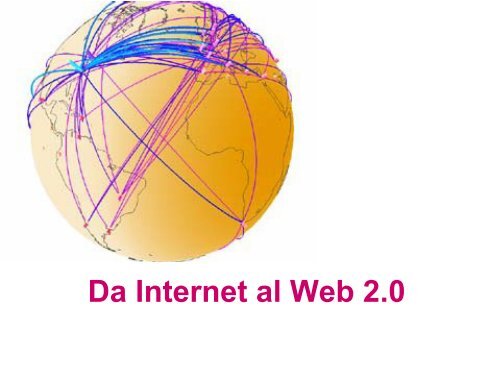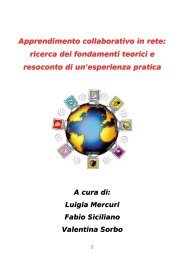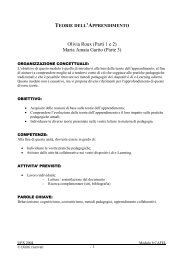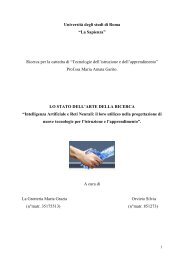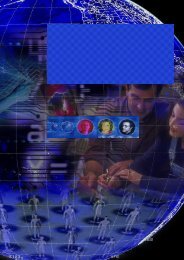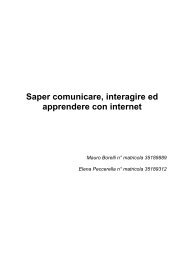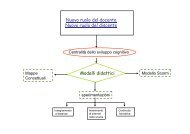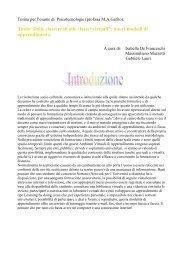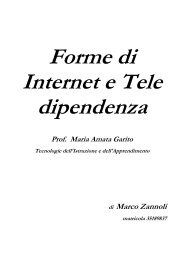Il Web 2.0 - Garito.it
Il Web 2.0 - Garito.it
Il Web 2.0 - Garito.it
You also want an ePaper? Increase the reach of your titles
YUMPU automatically turns print PDFs into web optimized ePapers that Google loves.
Da Internet al <strong>Web</strong> <strong>2.0</strong>
Da Internet al <strong>Web</strong> <strong>2.0</strong><br />
• Internet <strong>Web</strong><br />
• La nasc<strong>it</strong>a del <strong>Web</strong><br />
• <strong>Il</strong> <strong>Web</strong> Interattivo<br />
• <strong>Il</strong> <strong>Web</strong> <strong>2.0</strong>
Internet <strong>Web</strong><br />
1969: ARPANET
Internet <strong>Web</strong><br />
1969: ARPANET<br />
• Una società chiamata Bolt, Beranak and<br />
Newman (BBN) collegò quattro univers<strong>it</strong>à<br />
diverse: Stanford Univers<strong>it</strong>y, UCLA (Univers<strong>it</strong>y<br />
of California at Los Angeles), UCSB (Univers<strong>it</strong>y<br />
of California at Santa Barbara) e la Univers<strong>it</strong>y<br />
of Utah, usando linee telefoniche.<br />
• Nasce l’idea del “protocollo” NCP, un sistema<br />
per far comunicare client e server
Internet <strong>Web</strong>
Internet <strong>Web</strong><br />
1972: FTP<br />
• Diviene possibile trasferire file da un computer<br />
all'altro per mezzo del protocollo FTP (File<br />
Transfer Protocol)
Internet <strong>Web</strong><br />
1973/74: TCP/IP<br />
• Una raccolta di protocolli di comunicazione,<br />
ovvero: un sistema di standard che<br />
consentivano alle macchine di comunicare<br />
secondo un canale comprensibile e condiviso.<br />
• Combinando TCP/IP ed FTP si era giunti al<br />
coronamento dell'obiettivo tecnologico di<br />
ARPANet: trasferire dati di qualsiasi genere da<br />
un punto all'altro della rete.
Internet <strong>Web</strong><br />
1979 : NNTP - Usenet<br />
• E' la nasc<strong>it</strong>a di quelli che oggi vengono defin<strong>it</strong>i<br />
newsgroup. Viene sviluppato in ambiente<br />
univers<strong>it</strong>ario, ma fuori da Arpanet da T. Truscott<br />
e J. Ellis della Duke, lavorando con Steve<br />
Bellovin della Univers<strong>it</strong>y of North Carolina, che<br />
distribuiscono gratu<strong>it</strong>amente i programmi<br />
necessari al funzionamento delle discussioni<br />
telematiche
Internet <strong>Web</strong><br />
Internet: TCP/IP
Internet <strong>Web</strong><br />
1988 : IRCnet<br />
• Nel 1988 Jarkko Oikarinen, uno studente<br />
finlandese dell’Univers<strong>it</strong>à di Oulu, viene l’idea di<br />
creare un sistema di chat multiutente<br />
basandosi su alcuni sistemi già esistenti, come<br />
MUT (Multi User Talk), Talk per Unix o la BITnet<br />
Relay Chat.<br />
• in Finlandia si sviluppa ben presto una IRCnet<br />
univers<strong>it</strong>aria che permette a tutti gli studenti del<br />
paese di comunicare attraverso i loro terminali<br />
Unix.
Internet <strong>Web</strong><br />
1988 : IRCnet
Internet <strong>Web</strong><br />
Altri livelli si aggiungono,<br />
codificati da nuovi protocolli
La nasc<strong>it</strong>a del <strong>Web</strong><br />
1989 : Tim Berners Lee<br />
• Tim Berners-Lee propone al CERN<br />
un'organizzazione ipertestuale delle informazioni<br />
per permettere alle persone che lavorano<br />
insieme di accedere in modo immediato a<br />
risorse altrimenti difficili da reperire.
La nasc<strong>it</strong>a del <strong>Web</strong><br />
1990: HTTP<br />
• Tim Berners-Lee inventa il WWW: scrive le<br />
specifiche di HTML, scrive il primo client WWW<br />
(Enquire in formato testo e anche un tool<br />
grafico chiamato WorldWide<strong>Web</strong>, da cui il<br />
nome dato al web basato su Internet), il primo<br />
server WWW, inventa http e gli URL
La nasc<strong>it</strong>a del <strong>Web</strong><br />
1990: HTTP<br />
• HTTP: HyperText Transfer Protocol<br />
• HTML: HyperText Markup Language
La nasc<strong>it</strong>a del <strong>Web</strong><br />
1990: HTML<br />
• Linguaggio di marcatura per testi<br />
• = T<strong>it</strong>olo 1<br />
• = Paragrafo<br />
• = Tabella<br />
• = Unordered list (elenco puntato)<br />
• = Immagine<br />
• = Anchor: nasce il concetto di link
La nasc<strong>it</strong>a del <strong>Web</strong><br />
1992: Prima pagina <strong>Web</strong>
La nasc<strong>it</strong>a del <strong>Web</strong><br />
1993: Mosaic
La nasc<strong>it</strong>a del <strong>Web</strong><br />
<strong>Il</strong> <strong>Web</strong> nasce come ulteriore livello
La nasc<strong>it</strong>a del <strong>Web</strong><br />
Ogni livello ha il suo client di accesso
• Testo<br />
• Immagini<br />
• Link<br />
La nasc<strong>it</strong>a del <strong>Web</strong><br />
<strong>Il</strong> <strong>Web</strong> dei primordi<br />
• Contenuti prevalentemente scientifici<br />
(accademici)
<strong>Il</strong> <strong>Web</strong> interattivo<br />
Evoluzioni<br />
• Si evolvono i browser – nascono Netscape, Lynx<br />
poi Internet Explorer, Safari, Opera, fino al più<br />
recente Firefox<br />
• Nascono i linguaggi di scripting sia lato server<br />
sia lato client, che permettono ai browser di<br />
eserguire operazioni complesse
<strong>Il</strong> <strong>Web</strong> interattivo<br />
Evoluzioni<br />
• Cambia la modal<strong>it</strong>à di interazione<br />
• L’interazione non è più data dai click sul link, ma<br />
si può ricercare, si può scrivere una mail, si può<br />
upload-are e download-are file diversi<br />
dall’HTML, si possono consultare i newsgroup
<strong>Il</strong> <strong>Web</strong> interattivo<br />
Evoluzioni
<strong>Il</strong> <strong>Web</strong> interattivo<br />
Evoluzioni
<strong>Il</strong> <strong>Web</strong> interattivo<br />
Evoluzioni
<strong>Il</strong> <strong>Web</strong> interattivo<br />
<strong>Web</strong> come Gateway
<strong>Il</strong> <strong>Web</strong> interattivo<br />
Portali
<strong>Il</strong> <strong>Web</strong> interattivo<br />
Mainstream News
<strong>Il</strong> <strong>Web</strong> interattivo<br />
Logica del <strong>Web</strong> “1.0”<br />
• Portali come ambienti chiusi e pachidermici<br />
che tendono a trattenere l’utente<br />
• Contenuti protetti dal Copyright<br />
• Produzione di contenuti dall’alto verso il basso<br />
(redazioni)<br />
• Modello di business: pubblic<strong>it</strong>à (banner),<br />
audience (pay per view, pay per click)
<strong>Il</strong> <strong>Web</strong> <strong>2.0</strong><br />
Logica del <strong>Web</strong> “<strong>2.0</strong>”<br />
• Dal contetto di “Portale” a quello di “Servizio”<br />
• Decentralizzazione: più fonti, più servizi<br />
• Partecipazione: produzione di contenuti affidata<br />
agli utenti<br />
• Interoperabil<strong>it</strong>à: le funzioni del web <strong>2.0</strong><br />
possono essere riutilizzate, remixate, aggregate<br />
• Contenuti OpenSource o CreativeCommons<br />
• Modello di business: tagging, ranking,<br />
trackback e reputazioni.
<strong>Il</strong> <strong>Web</strong> <strong>2.0</strong><br />
Tecnologie principali<br />
• XML: eXtensible Markup Language: più che un<br />
linguaggio, una grammatica per costruire nuovi<br />
linguaggi di marcatura, e corredarli di un<br />
vocabolario in modo che siano comprensibili da<br />
tutti i sistemi<br />
• AJAX: Asyncronous Javascript and XML:<br />
avvicina la pagina <strong>Web</strong> ad una applicazione per<br />
desktop: tempi di caricamento ridotti, refresh<br />
diminu<strong>it</strong>i, manipolabil<strong>it</strong>à delle interfacce<br />
• RSS: Really Simple Syndication, formato per la<br />
ri-distribuzione di contenuti, permette la loro<br />
aggregazione all’esterno della fonte che li<br />
produce
<strong>Il</strong> <strong>Web</strong> <strong>2.0</strong>
<strong>Il</strong> <strong>Web</strong> <strong>2.0</strong><br />
I Blog
<strong>Il</strong> <strong>Web</strong> <strong>2.0</strong><br />
I Blog
<strong>Il</strong> <strong>Web</strong> <strong>2.0</strong><br />
Feed Reader
<strong>Il</strong> <strong>Web</strong> <strong>2.0</strong><br />
Aggregatori
<strong>Il</strong> <strong>Web</strong> <strong>2.0</strong><br />
Aggregatori
<strong>Il</strong> <strong>Web</strong> <strong>2.0</strong><br />
Social bookmarking
<strong>Il</strong> <strong>Web</strong> <strong>2.0</strong><br />
Tag Cloud
<strong>Il</strong> <strong>Web</strong> <strong>2.0</strong><br />
Photo sharing
<strong>Il</strong> <strong>Web</strong> <strong>2.0</strong><br />
Video sharing
<strong>Il</strong> <strong>Web</strong> <strong>2.0</strong><br />
Micro blogging
<strong>Il</strong> <strong>Web</strong> <strong>2.0</strong><br />
Social music
<strong>Il</strong> <strong>Web</strong> <strong>2.0</strong><br />
Social network
<strong>Il</strong> <strong>Web</strong> <strong>2.0</strong><br />
Social network
<strong>Il</strong> <strong>Web</strong> <strong>2.0</strong><br />
<strong>Web</strong> TV
<strong>Il</strong> <strong>Web</strong> <strong>2.0</strong><br />
Mash-up: aggregazione di servizi
<strong>Il</strong> <strong>Web</strong> <strong>2.0</strong><br />
Mash-up: aggregazione di servizi
<strong>Il</strong> <strong>Web</strong> <strong>2.0</strong><br />
Modelli di Business<br />
• The long Tail (Chris Anderson, 2004)
• Ranking<br />
<strong>Il</strong> <strong>Web</strong> <strong>2.0</strong><br />
Modelli di Business<br />
• <strong>Il</strong> link è la moneta di scambio
• Reputation<br />
<strong>Il</strong> <strong>Web</strong> <strong>2.0</strong><br />
Modelli di Business<br />
• <strong>Il</strong> passaparola online diventa decisivo per il<br />
successo di una campagna promozionale.
• Viral Marketing<br />
• Buzz Marketing<br />
<strong>Il</strong> <strong>Web</strong> <strong>2.0</strong><br />
Modelli di Business
<strong>Il</strong> <strong>Web</strong> <strong>2.0</strong><br />
L’utente E’ il contenuto E’ il business<br />
• <strong>Il</strong> modello di pubblic<strong>it</strong>à regge ancora<br />
• Più utenti -> più contenuti<br />
• Più contenuti -> più link<br />
• Più link -> più ranking<br />
• Più ranking -> più vis<strong>it</strong>e<br />
• Più vis<strong>it</strong>e -> più soldi
• Google sa:<br />
<strong>Il</strong> <strong>Web</strong> <strong>2.0</strong><br />
Tanti servizi, tante informazioni<br />
• Cosa leggo (motore di ricerca, gMail)<br />
• Cosa scrivo (Blogger.com)<br />
• Cosa vedo (YouTube)<br />
• Che documenti produco (GoogleDocs)<br />
• Che blog seguo (GoogleReader)<br />
• Quanta gente legge il mio s<strong>it</strong>o (Google<br />
Analytics)
<strong>Il</strong> <strong>Web</strong> <strong>2.0</strong><br />
<strong>Il</strong> <strong>Web</strong> <strong>2.0</strong> come<br />
tecnologia per l’istruzione e<br />
l’apprendimento<br />
• Quali tecnologie?<br />
• Come sono usate? In quali amb<strong>it</strong>i?<br />
• Quali sono quelle che non sono ancora state<br />
utilizzate?<br />
• Quali sono i possibili utilizzi non ancora<br />
sperimentati?


